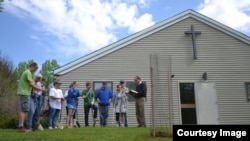Trees are good for us. They give us oxygen, absorb carbon dioxide and provide habitat for wildlife. There are 3 trillion trees on the planet, according to a new study led by Yale University researchers.
But we are losing 10 billion trees a year to agriculture, urbanization, wildfires and disease.
Communities of faith are making a difference in reversing that trend. What they have in common is respect for creation and a commitment to protect the Earth. That is playing out in Maryland with an incentive of free trees from Department of Natural Resources directed to houses of worship across the state.
Over 50 congregations have already joined to plant 10,000 trees.
Several dozen of those trees now grace the Sanctuary Retreat Center, located in a rural area of Montgomery County, about an hour’s drive northwest of downtown Washington, D.C. On a recent day, its landscape of rolling farmland and forested hills offers a dazzling display of yellow, red and orange.
Sanctuary’s founder, Rabbi David Shneyer, has recruited volunteers from Kehila Chadasha synagogue to replace trees lost in a recent storm.
Trees are intimately connected to Jewish life, he tells them: “Our Torah, our sacred writings, is also called a tree of life. So the imagery of the tree reflects the deep spirit of the human being and also of the teachings of our Torah.”
The community is honoring those teachings by planting a grove of 50 trees. "And by being in touch with nature, we are in touch with ourselves," Shneyer says. "One of the names for God in the rabbinic tradition is Teva, is Nature."
Trees help nation’s largest estuary
The retreat center is bordered by Dry Seneca Creek, a tiny waterway that feeds into a network of streams and rivers flowing into the Chesapeake Bay, the nation’s largest estuary. The bay touches the lives and livelihoods of 17 million people in six states and the nation’s capital.
Dan Brellis is a program manager with the Alliance for the Chesapeake Bay, which administers the Trees for Sacred Places project, along with Interfaith Partners for the Chesapeake. Their aim is to reverse the tide of tree loss and protect the estuary.
"While these trees are many kilometers away from the bay," he explained, "they help slow polluted runoff. The health of this stream is a great indicator for the health of the bay as a whole."
Brellis is pleased with the day’s turnout.
"We’ve got the congregation volunteers out. It gives them a great investment," he said. "They get their hands dirty. And they build that connection with the bay."
Volunteers see benefit to watershed
Working side by side, Kehila Chadasha members Jonathan Davidson and Debby Levenson say that even two trees can make a difference.
"I've learned a lot by planting these trees," Davidson said. "They absorb a lot of the damaging nutrients that otherwise drain into the bay."
Levenson added, "And the more trees we have, the more biodiversity we have and it’s a healthier planet that way, right?!"
That’s certainly the way Shneyer sees it.
Looking over the day's work, the rabbi says he feels the spirit of the Divine: "That God speaks to us from a blade of grass. That God speaks to us from the beauty of the trees in whatever season they are in. That is one of the ways that the Creator speaks to us as human beings."
Shneyer is moved to say a prayer, blessing the new life growing at Sanctuary: "Blessed is the source of life, the majesty of the universe, who has given us life and who has sustained us and enabled us to reach this day, to reach this season."










